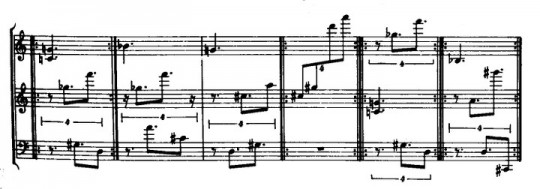
As I noted in a recent post, I have decided it is time I learned Morton Feldman’s Triadic memories. Composed in 1981, it is a lengthy work (it lasts about one to one-and-a-half hours) that is an early example of Feldman’s late period style based on slowly changing repeated patterns.
Step one was to get a copy of the score. Some time ago I posted here about the two formats in which you can get Feldman’s music: facsimiles of Feldman’s manuscript and versions typset using standard music notation software. As I described in that earlier post, information is lost in the conversion of manuscript to computer-copied notation. Feldman’s compositional practice was heavily conditioned by the actual layout of measures on the manuscript page—what he called “the grid”—but this layout is lost in most of the later typeset editions. In some ways the computer layout—with perfect ledger lines and alignment of voices—is easier to read, but for someone wanting to do analysis of the score and gain a deeper understanding of the creation of the music, the manuscript version is essential. A good introduction to some of the issues involved is found in an article by Tom Hall (see particularly the section on “Musical typesetting and the notational image” on page 19).
I already had a copy of an older typeset score from Universal Edition (UE 17326). But this version, I discovered, not only lost contact with Feldman’s manuscript “grid” but also contained numerous serious errors. Throughout the 49-page score many sets of 2–3 measures are marked to be repeated different numbers of times: 2, 3, 4, 5, even up to 9 times. The printed score from Universal marked the repeats but omitted all of the indications of the number of repetitions. This renders the work unperformable from this score. Universal has since issued a new, corrected edition (UE 21448).
So I knew I needed to get a new copy of the score, but what I really wanted was a facsimile of the manuscript. The Universal website does not list such an edition, only the corrected typeset version in both print and PDF. While manuscript facsimile was the standard format for Feldman scores from Universal in the 1980s, these are being taken out of the catalog in favor of the newer computer-made scores.
Happily, I found that there is a way to get a manuscript facsimile score. I asked around and was given the suggestion of contacting Universal directly. I e-mailed the sales department in Vienna and found that yes, you can get this version (UE 21560) as a special order for a pretty hefty cost (over double the price of the regular edition). Despite the extra cost, I was delighted to be able to have access to this version of the score, placed my special order, and received the score in a week or two. I highly recommend this process to those who are interested in really learning Feldman’s music and who have the financial resources to afford it.
I’m sure there are other pianists who will feel differently, but I actually find that I prefer playing from the Feldman manuscript scores. Here’s the same passage in each format:


It may be just that I’ve gotten accustomed to Feldman’s handwriting, but I find the manuscript scores easier to read. This might be because the bars are all the same size, which I find makes it easier to scan visually. I prefer the lightness of Feldman’s handwriting; the typeset scores seem heavy and cluttered, especially the thick lines of the repeated bars.
And then there are the less tangible advantages of the manuscript scores. Feldman’s music is singularly tactile with a strong quality of being hand-made: the slight rhythmic modifications, the gradual evolution of motives, the sense of discovery through time. The computer typesetting gives the score a coldness, regularity, certainty, and sense of inevitability that contradicts the music’s true nature. Feldman’s writing down of the music was by all accounts a critical part of his way of working. By playing from his hand-written scores, I feel a stronger connection to Feldman as a composer.
And recently, with Triadic memories, I found that the manuscript score actually illuminates a matter of performance practice that would remain completely invisible if all I had access to was the newer printed scores. I’ll write about that in my next post.

James,
Am I seeing correctly that the typeset version doesn’t portray the number of repeats that are specified in the facsimile? Or are they placed higher than what was scanned in the image?
Yes, that’s correct. I have an older copy of the original edition which omitted all the repeat numbers, a horrible mistake! Subsequent editions corrected this problem, and the typeset version available from Universal contains them.
Hi. I found exactly the same problems. The early edition of Triassic Memories is hopelessly defective and the new one still doesn’t tell the whole story either. Like you, I was able to get a correct pdf. I would dearly love to see the original ms for Palais de Mari, which I am convinced will help get to the deep structure of the piece. Any ideas, short of travelling to the Paul Sacher Archive in Switzerland? Apparently there’s nothing at Buffalo University. Regards Tom